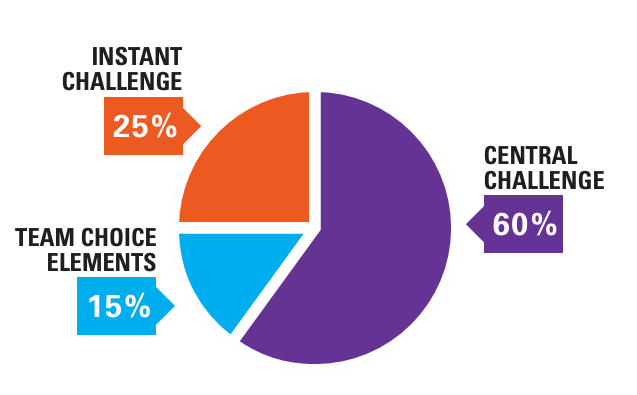What makes Destination Imagination?
There is a lot that goes into Destination Imagination which can make it hard when being first introduced to Destination Imagination. Let’s break down each component of the process!

A Destination Imagination Team
A team consists of at least two and no more than seven members. Only those seven may work on the solution to the Team Challenge, may perform the solution and may participate in the Instant Challenge part of a tournament.
When forming teams, keep in mind that all teams will need individuals who have talents and abilities in very diverse areas such as building, welding, soldering, sewing, designing sets, designing costumes, writing scripts, composing and performing music, just to name a few.
Teams will also need individuals who have the ability to generate ideas and those who are able to categorize, sift and choose criteria to make the solution work. They need people who can generate many ideas and options for their solution. They also need people who can focus on the many ideas generated and choose those that are considered the best, most unique and useful for their solution.
Teams should have members who are willing to commit their time and energy to the development of the solution and to each other through thick and thin. If teams do not have the skills they need, those skills may be taught. Resources (e.g., human, books, journals, videos, etc.) may be used to help teach the skills to team members. However, the team may not be taught skills specifically tailored for application to its Team Challenge solution. Team members must learn the skills apart from their solution, and then apply their new skills when they work toward the development of their solution. Team members do not have to be the same age. However, the Level in which the team will compete is determined by the age of the oldest child or the highest grade level.
The Team Challenge
There are six new competitive Challenges to choose from each year. The areas of focus include: Technical, Scientific, Fine Arts, Improvisational, Structural and Service Learning. There is also a non-competitive Early Learning Challenge. Our current season’s Challenges can be found here. The Team Challenge is the combination of the Central Challenge and Team Choice Elements. After developing solutions to Team Challenges, teams can attend tournaments to showcase their solutions in front of Appraisers and live audiences.
Central Challenge
The Central Challenge encourages development of critical thinking, problem solving techniques, teamwork and the creative process over a sustained period of time (usually 2 to 4 months). The team will choose one of the six possible challenges that focus on different subjects and develop a solution according to the challenge.
Team Choice Elements
Team Choice Elements are team-selected elements that are incorporated with the Central Challenge to allow creative freedom in showcasing additional strengths.
Instant Challenge
Instant Challenges require teams to engage in quick, creative and critical thinking.
At a tournament, a team will receive an Instant Challenge and the materials with which to solve it. The team members must think on their feet by applying appropriate skills to produce a solution in a period of just 5 to 8 minutes.
In a world with growing cultural connections, increased levels and types of communication, and a new need for real-time teamwork and problem solving, the ability to solve problems quickly is becoming increasingly critical.
Instant Challenges are performance-based, task-based, or a combination of the two. Although each Instant Challenge has different requirements, all Instant Challenges reward teams for their teamwork. Instant Challenges are kept confidential until the day of the tournament.
Destination Imagination Tournament
The DI tournament is a culminating celebration of what the teams have learned throughout the year. It celebrates their teamwork, problem solving and time management skills they have learned on the way to their Challenge solution.
At the tournament, Destination Imagination teams will solve two types of Challenges: Team Challenges and Instant Challenges. Teams will perform their Challenge solutions to a group of Appraisers. Destination Imagination Appraisers are local volunteers who have been trained to assess the Challenges.
The team’s score will be based on three components to create an overall score: Instant Challenge, Team Choice Elements, and the Central Challenge.
A DI tournament is not apart from the process; it is a part
of the DI process.
A tournament:
-
- is fair and consistent.
- has officials who understand and honor the DI
process. - considers every team a winner.
When we say every team is a winner, what do they win?
They have won the ability to:
-
- have self-confidence to generate options.
- learn to take focused risks.
- make decisions with efficiency.
- take action with a positive outlook.
The DI process is not just for kids! One of the great benefits for adults who are participating in DI, whether as Team Managers or as officials, is the opportunity to learn the same skills DI teaches the young people on teams.
So the tournament is not just a celebration for the teams: it is a celebration for everyone, adults as well as children, at the tournament!
So now that we know a little bit about the components of Destination Imagination what does a challenge actually look like? Below is a great example of a team discussing their Team Challenge solution in detail!

